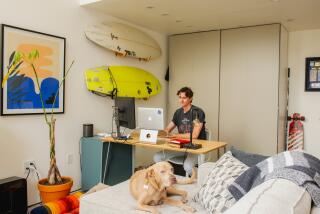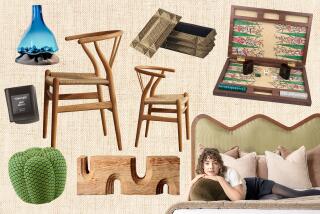The Apartment
Think good interior design requires lots of money?
John Cottrell, a designer whose work appears regularly in Architectural Digest, doesn’t.
Which is not to say that he hasn’t decorated some pretty tony abodes, including his own in Los Angeles.
But when it came to his getaway apartment at the Balboa Bay Club in Newport Beach, the accent is on less.
“There’s a side of me that loves simplicity,” Cottrell says. “Even though I am one of the most materialistic people you’d ever run into with many possessions, I really love casual. That’s the real me. And what I especially like are natural fabrics and clean looks.”
To achieve that in the 700-square-foot, one-bedroom space, Cottrell turned a never-used balcony into a sitting area that doubles as a casual eating spot. He painted the walls throughout the apartment a dark gray, an admittedly odd choice for the waterfront.
“I was worried about it at first,” he says. “But it makes the light outside and inside even lighter.”
The dark walls contrast with light-colored furniture slip-covers to create a Manhattan-meets-Malibu look that is both sophisticated and breezy.
For the upholstered furniture, he covered everything in “junky Egyptian cotton” he found at Diamond Foam in Los Angeles.
In the bedroom he uses a sheet instead of a bedspread, which he dislikes because “they take up too much room. What really is the purpose of them?”
For wall decoration, he used paintings he had in a house he recently sold and seven sombreros.
“I love the look of [sombreros], and they make inexpensive decorations. I had them put in Lucite frames at Emilio’s on Pico Boulevard in Los Angeles and then I’ve used them throughout the apartment.”
The furniture is a mix of antiques and inexpensive items. He’s combined both wood furniture and wicker pieces in different natural shades to add interest.
“I’ve always said I can make a great house from Cost Plus and Pottery Barn,” he says. “There’s something wonderful about a look that is fresh and young. Not everybody can afford antiques, and when you buy them, it’s a big commitment. I like the idea of being light of things.”
The dining room chairs sell for about $40 at Cost Plus, and the dining room table is a top from Cost Plus with a marble base. On the table are several black sake bottles--now vases--in a bamboo tray.
Behind the living room sofa are wooden sliding doors from Cost Plus that act as a large mural. In front of the sofa are ottomans that double as coffee tables with the addition of trays.
“I love slip-covered rooms; I don’t like things tight. There’s something inviting about softness,” he says.
One couch is a single bed with a huge pillow as its back. When Cottrell has a visitor, it can be quickly transformed into a bed. It also divides the dining room from the living room because it juts out from the wall.
The two chairs in front of the sliding glass windows swivel to take in the bay-front views from all angles, and the banquette in front of the bedroom window can serve as a bed, a seat for dining on or just a place for relaxing and reading.
Since so many items serve dual purposes, this small apartment seems much larger than it really is. And it does manage to reflect Cottrell’s design style, which he terms “traditional but happy.”
“One house I saw when I was young influenced me: There was French provincial furniture, modern furniture, a real hodgepodge of stuff. I thought how fabulous it was that people could have such interests, that everything didn’t have to look the same. To me, that’s real design.”


